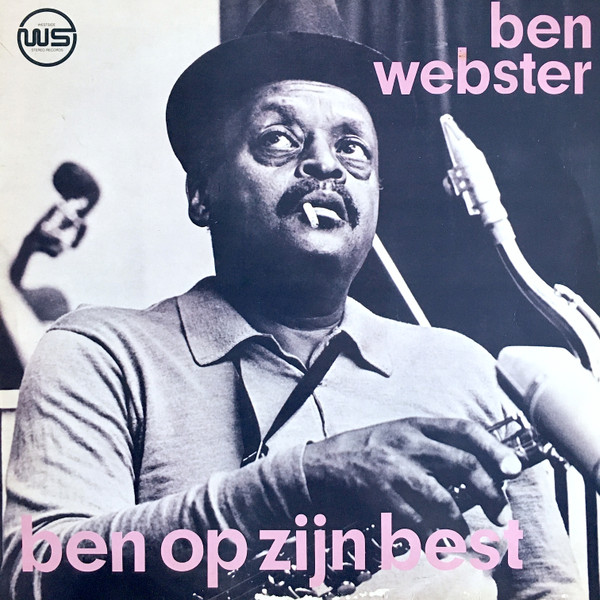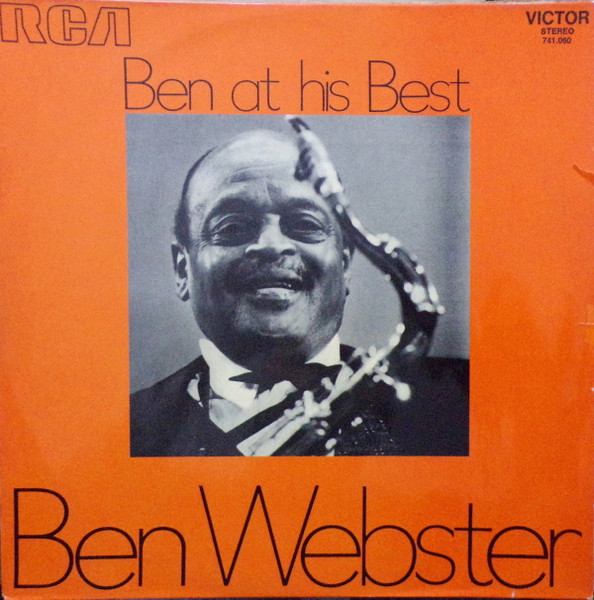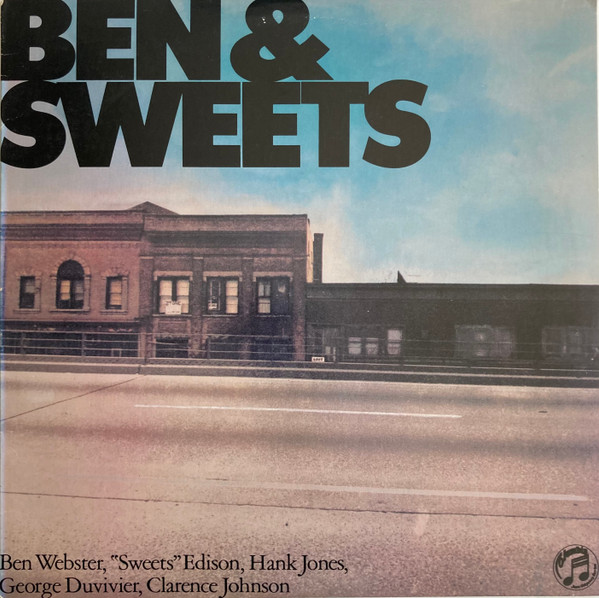Startseite › Foren › Über Bands, Solokünstler und Genres › Eine Frage des Stils › Blue Note – das Jazzforum › Tenor Giants – Das Tenorsaxophon im Jazz
-
AutorBeiträge
-

Ben Webster – Ben Op Zijn BestGeburtstag?! da leg ich doch direkt hiermit an, aufgenommen etwa ein Jahr später für das Label der Albert Heijn Supermärkte, mit einer ähnlichen Rhythmusgruppe (Rob Langereis statt Schols) und noch drei niederländischen Bläsern dazu, den Herren Ray Kaart (tp), Ruud Brink (ts) und Herman Schoonderwalt (as)… „Op Zijn Best“ also „von seiner besten Seite“ im Titel verspricht ein bisschen zuviel, aber es ist schon ein schönes Album, Webster steht trotz den anderen Bläsern im Vordergrund, und Brink aus der Pres-Getz-Schule als Kontrast zu Webster ist natürlich ein Plus (zumal ich Brink ohnehin sehr mag)
--
.Highlights von Rolling-Stone.deWerbungredbeansandrice

Ben Webster – Ben Op Zijn Best
Geburtstag?! da leg ich doch direkt hiermit an, aufgenommen etwa ein Jahr später für das Label der Albert Heijn Supermärkte, mit einer ähnlichen Rhythmusgruppe (Rob Langereis statt Schols) und noch drei niederländischen Bläsern dazu, den Herren Ray Kaart (tp), Ruud Brink (ts) und Herman Schoonderwalt (as)… „Op Zijn Best“ also „von seiner besten Seite“ im Titel verspricht ein bisschen zuviel, aber es ist schon ein schönes Album, Webster steht trotz den anderen Bläsern im Vordergrund, und Brink aus der Pres-Getz-Schule als Kontrast zu Webster ist natürlich ein Plus (zumal ich Brink ohnehin sehr mag)Todestag!
Wenn er 1973 geboren worden wäre, wäre er wohl noch bei uns – aber dann wäre er wohl kein solch charaktervoller Tenorsaxofonist geworden.

Obskure Alben hat Webster in Europa gemacht. Guv’nor wurde nur in Europa veröffentlicht, Ben Op Zijn Best mit diesem Titel natürlich auch nur in den Niederlanden. In Frankreich kam das Album so auf den Markt:

--
“There are legends of people born with the gift of making music so true it can pierce the veil between life and death. Conjuring spirits from the past and the future. This gift can bring healing—but it can also attract demons.” (From the movie Sinners by Ryan Coogler)
soulpope "Ever Since The World Ended, I Don`t Get Out As Much"Registriert seit: 02.12.2013
Beiträge: 56,976
https://www.nytimes.com/2023/09/22/arts/music/sam-rivers-centennial-studio-rivbea.html
--
"Kunst ist schön, macht aber viel Arbeit" (K. Valentin)Bei NYTimes-Artikeln bitte immer davon ausgehen, dass die anderen ihren einen halbjährlichen Freiartikel schon aufgebraucht haben

--
"Don't play what the public want. You play what you want and let the public pick up on what you doin' -- even if it take them fifteen, twenty years." (Thelonious Monk) | Meine Sendungen auf Radio StoneFM: gypsy goes jazz, #168: Wadada & Friends - Neuheiten 2025 (Teil 2) - 9.12., 22:00 | Slow Drive to South Africa, #8: tba | No Problem Saloon, #30: tba
soulpope "Ever Since The World Ended, I Don`t Get Out As Much"Registriert seit: 02.12.2013
Beiträge: 56,976
gypsy-tail-wind Bei NYTimes-Artikeln bitte immer davon ausgehen, dass die anderen ihren einen halbjährlichen Freiartikel schon aufgebraucht haben

Aha ok, das habe ich nicht bedacht ….
--
"Kunst ist schön, macht aber viel Arbeit" (K. Valentin)Das war eigentlich eine Bitte, ein paar Zitate einzustellen zum Link

--
"Don't play what the public want. You play what you want and let the public pick up on what you doin' -- even if it take them fifteen, twenty years." (Thelonious Monk) | Meine Sendungen auf Radio StoneFM: gypsy goes jazz, #168: Wadada & Friends - Neuheiten 2025 (Teil 2) - 9.12., 22:00 | Slow Drive to South Africa, #8: tba | No Problem Saloon, #30: tba
soulpope "Ever Since The World Ended, I Don`t Get Out As Much"Registriert seit: 02.12.2013
Beiträge: 56,976
How Sam Rivers and Studio Rivbea Supercharged ’70s Jazz in New York
The East Village venue wasn’t just a performance space — it was Rivers’s home. On the saxophonist’s centennial, Jason Moran and other artists celebrate his legacy.
By Richard Scheinin
Sept. 22, 2023
A handful of New York venues can be credited with generating era-defining scenes. In the 1970s, CBGB, perhaps the best known, was just a stone’s throw from Studio Rivbea, a dingy and miraculous little performance space — and a key energy center for the decade’s revolutionary jazz. It was also the home of the saxophonist Sam Rivers, his wife, Bea, and their children. The family would greet you at the door, take your $4 and send you down a creaky wooden staircase to the basement, where the adventure would begin;
“It was a mecca,” said the bassist and downtown guru William Parker. “It was a time of self-determination and musicians doing for themselves. Sam wasn’t working the clubs, so he created his own space.
Born Sept. 25, 1923 — a century ago next week — Rivers was both traditionalist and avant-gardist, a Promethean improviser and prolific composer, an entrepreneur and scene maker wherever he went. He played with Billie Holiday and Jimi Hendrix, Miles Davis and Cecil Taylor, T-Bone Walker and Joe Cocker, not to mention the conductor Seiji Ozawa. In the early ’70s, a time of fervent underground jazz innovation, artist-run jazz lofts, as they were known, cropped up all over Lower Manhattan. Studio Rivbea, on a forlorn block in the East Village, was formative. The music could go on all night — band after band, a maelstrom of righteous sound that defined the era.
“The copycats make money, but they’re not the ones making their own vistas,” Rivers said in a 1999 interview. “I’m into making vistas.
Rivers died in 2011 at age 88, but his D.I.Y. jazz loft remains a model for a new generation of independently minded artists: “It’s the future of where we need to go as musicians if we want to keep evolving,” said the pianist Jason Moran, who runs his own record label and will perform inside a Recording and touring with Rivers in the early aughts, Moran was “ushered to the next level,” he said. He links Rivers’s early ’70s innovations at Rivbea to the hip-hop experiments of DJ Kool Herc in the Bronx. They represent two sides of “the Black freedom struggle that was happening in the city at that same moment, with musicians going off grid and getting free, making music for the people,” he said. “That’s how revolutions start and then reverberate.
Rivers’s revolution is being celebrated anew. A year ago, Rick Lopez, a music researcher in Erie, Pa., published “The Sam Rivers Sessionography: A Work in Progress,” an astonishing 768-page tome. A book on Rivbea by the jazz writer Ed Hazell is in the works. And Rivers’s archives — including more than 500 handwritten scores and over 300 audio and video recordings dating from 1957 to 2007 — were acquired in February by the University of Pittsburgh Library System. Concerts of his music planned this month and next in Harlem, will commemorate Rivers’s centennial and remind listeners of his powerful accomplishments“It’s Sam’s time,” said the tuba player Joseph Daley, who worked with the saxophonist for close to 30 years. Daley, who used to jog miles every day to stay in shape for Rivers’s marathon performances, recalled a big band concert in Mount Morris Park in Harlem: “The rain was pouring down and the stage wasn’t covered, but Sam just kept going and going and going. Oh, it was one of the most glorious concerts — and Sam was playing the hell out of his instrument.” He likened his friend’s improvisations to “a serpent, sliding through the environment.
Rivers was born on the road, in El Reno, Okla., while his mother (a pianist) and father (a gospel singer) toured with the Silvertone Quintet. In 1947, after a stint in the Navy, he enrolled at the Boston Conservatory. Deep into the local jazz scene, he studied composition, attended a lecture by Igor Stravinsky, and connected with the drummer Tony Williams, a child prodigy who was 13 when he joined Rivers in an experimental trio in 1959. (The renowned Williams would later instigate Rivers’s 1964
Rivbea was located at 24 Bond Street, in a building owned by Robert De Niro’s mother, the poet and painter Virginia Admiral. Bea Rivers (for whom Rivers composed his enduring ballad managed the place when her husband was on the road and served up platters of fragrant chicken. The loft “had a homey vibe,” said Hazell, the author. “The furniture was all secondhand; it was like being in their living room — relaxed, relatable.
It became a nexus of the Black creative arts scene: Davis might stroll in, or Ntozake Shange, who workshopped her Broadway-bound “For Colored Girls Who Have Considered Suicide/When the Rainbow Is Enuf” at Rivbea. Patti Smith was around, too; her friend Robert Mapplethorpe, the photographer, had a studio on the building’s fourth floor. At showtime, fans would gather in the basement, where it could get as hot as a blast furnace. A large parachute — Rivers had picked it up at a military surplus store on Canal Street — hung from the ceiling.
Around 10 or 11 p.m., the musicians would wander in and the performance would begin. The entry fee could get you three or more bands per night, typically led by budding stars of the avant-garde: Parker, David Murray, Henry Threadgill, Oliver Lake. They were all booked by Rivers, who funded Rivbea with grant money and played there regularly with his own groups: sextets, woodwind choirs, a big band.
But his trio was his calling card. Its virtuoso sets would go on for an hour or two without pause — bracing, improvised from scratch, yet sounding like a seamless conversation, encompassing breakneck swing, funk vamps and free-form blowouts. It was a visual treat, too. Rivers, in his big floppy hat and colorful dashiki, would go full tilt on tenor saxophone, then soprano sax, flute and piano, hooting and screaming as he switched instruments
Rivbea closed in 1978: The building flooded and rents were rising. But later, during his four yearson the road with Dizzy Gillespie, Rivers stopped in Orlando, where local music pros urged him to settle down. Hundreds of musicians were working at Disney World or doing corporate gigs — well-paid and bored, they were thirsty for a challenge.
He and Bea moved there in 1991, and when Rivers called his first big band rehearsal, the line of candidates was out the door. He hired a drummer named Anthony Cole, a nephew of Nat King Cole who also played saxophone and piano, and later a bassist named Doug Mathews, who doubled on bass clarinet. The trio became the heart of Rivers’s new big band, for which he composed constantly.
„justify“ Moran first heard Rivers with this trio in New York, in the ’90s: “I was like, What? Who are these three magicians, jumping from instrument to instrument? It was insane. And who is this man, this bold guy screaming into the microphone with his saxophone and voice?”
Within a few years, Moran and Rivers were touring — “a life-changing experience,” Moran said. Rivers didn’t tell him what to do, but, by example, he showed him a way to be in the world. Rivers was around 80, but his energy was off the charts. He would leap three feet onto a stage. He was always “ready to make it happen — and he was ready to do it again if he didn’t like what he did the first time,” Moran said. “It set me up to play with people who are completely singular.
Moran’s own trio, the Bandwagon, developed much of its distinct language and flow while touring with Rivers. Spending time with “this bold guy” was liberating, Moran said.
“He literally made the lane that I’m riding in.
The New York All-Star Rivbea Orchestra performs Sept. 22 at the Mount Morris Ascension Presbyterian Church in Harlem; harlemjazzboxx.com--
"Kunst ist schön, macht aber viel Arbeit" (K. Valentin)
soulpope "Ever Since The World Ended, I Don`t Get Out As Much"Registriert seit: 02.12.2013
Beiträge: 56,976
gypsy-tail-wind Das war eigentlich eine Bitte, ein paar Zitate einzustellen zum Link

Ja eh, aber ich musste mich mal für diesem „Formatkorrektur Marathon“ motivieren
 … jetzt aber ein grosser Espresso ….
… jetzt aber ein grosser Espresso ….--
"Kunst ist schön, macht aber viel Arbeit" (K. Valentin)Danke – lese ich gleich!
Und fürs nächste Mal: vor dem Einfügen in den Text-Modus wechseln, dann ist fast keine Bearbeitung nötig!
--
"Don't play what the public want. You play what you want and let the public pick up on what you doin' -- even if it take them fifteen, twenty years." (Thelonious Monk) | Meine Sendungen auf Radio StoneFM: gypsy goes jazz, #168: Wadada & Friends - Neuheiten 2025 (Teil 2) - 9.12., 22:00 | Slow Drive to South Africa, #8: tba | No Problem Saloon, #30: tba
soulpope "Ever Since The World Ended, I Don`t Get Out As Much"Registriert seit: 02.12.2013
Beiträge: 56,976
gypsy-tail-wind Danke – lese ich gleich! Und fürs nächste Mal: vor dem Einfügen in den Text-Modus wechseln, dann ist fast keine Bearbeitung nötig!
Ok, thnx ….
--
"Kunst ist schön, macht aber viel Arbeit" (K. Valentin)gypsy-tail-windBei NYTimes-Artikeln bitte immer davon ausgehen, dass die anderen ihren einen halbjährlichen Freiartikel schon aufgebraucht haben

@gypsy-tail-wind
Das Zauberwort heißt https://archive.is
--
Reality is that which, when you stop believing in it, doesn't go away. Reality denied comes back to haunt. Philip K. DickDanke!
--
.kannte ich auch noch nicht, danke!
--
Danke @nicht_vom_forum

--
"Don't play what the public want. You play what you want and let the public pick up on what you doin' -- even if it take them fifteen, twenty years." (Thelonious Monk) | Meine Sendungen auf Radio StoneFM: gypsy goes jazz, #168: Wadada & Friends - Neuheiten 2025 (Teil 2) - 9.12., 22:00 | Slow Drive to South Africa, #8: tba | No Problem Saloon, #30: tba
Ben Webster & Harrry „Sweets“ Edison – Ben & Sweets (1962)
Ich habe dieses Album in einer Re-Issue von 1981 mit dem oben gezeigten Cover. Ursprünglich hieß das Album wohl mal „Ben Webster & Harrry „Sweets“ Edison Wanted To Do One Together“, was auch gleichzeitig der erste Satz der liner notes war und das Album sah so aus.
Was zeigt das Cover meiner Ausgabe eigentlich? Straßenansicht von Kansas City von einem Highway aus?
Ein Treffen zweier Veteranen der Swing-Ära, ein Tenor- und ein Trompetengigant, einer ex-Ellington, einer ex-Basie. Da könnte man eine Jamsession mit ein paar spektakulären Soli befürchten. Hier bekommt man aber stattdessen ein sorgfältig konzipiertes Album. Sehr schön ge-sequenztes Programm: Better Go ist ein uptempo Swinger mit Ben und Sweets, How Long Has This … eine Ballade mit nur Webster als Bläser, Kitty mid-tempo mit beiden, My Romance wieder nur Webster, Did You Call Her Today ein gelassener groover mit beiden und abschließend Embraceble You nur mit Sweets. Die up- und mid-tempo Stücke schön stramm gestrickt mit unisono Riffs von Ben und Sweets, die wie ein kleiner Bläsersatz klingen. Die Balladen hingegen viel lockerer gestrickt, so das Webster und Sweets die Melodie frei umspielen können.
Ben und Sweets bilden ein schönes kontrastreiches Paar an Sax und Trompete mit ihrer jeweils charakteristischen Stimme. Sweets durchgehend an der gestopften Trompete, klar und kristallin aber nicht aufdringlich. Ich hatte ja schon versucht, das Spiel von Ben Webster zu beschreiben. Von herb und zupackend, manchmal sogar ruppig, bis sanft und blütenzart. Hier dachte ich an einen Schauspieler, dessen Mimik in all ihren Nuancen in Musik abgebildet wird – aber man sieht dabei immer das gleiche Gesicht. „Als seien Musik und Körper von der selben Haut umhüllt.“ (Roland Barthes). Hank Jones (p), George Duvivier (b) und Clarence Johnson (dr) bilden eine im besten Sinne wie geschmiert swingende Grundlage. Ein gut gefedertes Fahrwerk mit dem man flott durch die Kurven kommt.
Die Kombination von Websters Sax und Sweets’ Trompete ist toll. Sicher ein Höhepunkt in der Diskografie der beiden.
--
“There are legends of people born with the gift of making music so true it can pierce the veil between life and death. Conjuring spirits from the past and the future. This gift can bring healing—but it can also attract demons.” (From the movie Sinners by Ryan Coogler) -
Schlagwörter: Jazz, Tenor Sax, Tenorsaxophon
Du musst angemeldet sein, um auf dieses Thema antworten zu können.